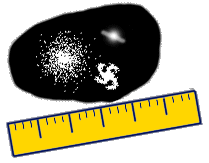 Now you have a good sense of how astronomers use Cepheid variables to
determine the extragalactic distance scale, the expansion rate of the
universe, and the age of the universe. You've also seen how they can
glean some information about the ultimate fate of our universe. Many
other galaxies were studied as part of the HST Key Project on the
Extragalactic Distance Scale.
Now you have a good sense of how astronomers use Cepheid variables to
determine the extragalactic distance scale, the expansion rate of the
universe, and the age of the universe. You've also seen how they can
glean some information about the ultimate fate of our universe. Many
other galaxies were studied as part of the HST Key Project on the
Extragalactic Distance Scale.Although Cepheids are primary distance indicators, the most fundamental means of determining distances is trigonometric parallax. It is difficult to make accurate parallax measurements for all but the nearest stars, but good parallax measurements supersede any other method of distance determination. Recent parallax measurements of galactic Cepheids made with the Hipparcos satellite require us to adjust the Cepheid distance scale.
You can see that science is a process, not a collection of facts. Just as Edwin Hubble's discoveries required the astronomers of his day to adapt to new information, astronomers today must also continually reassess and adjust their models to fit new data. The process will continue as long as people survive. The role of an astronomer is to constantly push back the barriers of our understanding of the universe.
Back to the table of contents